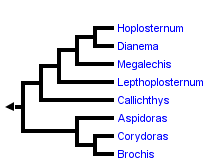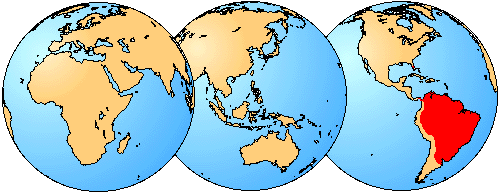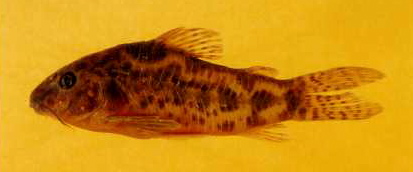Callichthyidae
Armored Catfishes
Roberto E. Reis


This tree diagram shows the relationships between several groups of organisms.
The root of the current tree connects the organisms featured in this tree to their containing group and the rest of the Tree of Life. The basal branching point in the tree represents the ancestor of the other groups in the tree. This ancestor diversified over time into several descendent subgroups, which are represented as internal nodes and terminal taxa to the right.

You can click on the root to travel down the Tree of Life all the way to the root of all Life, and you can click on the names of descendent subgroups to travel up the Tree of Life all the way to individual species.
For more information on ToL tree formatting, please see Interpreting the Tree or Classification. To learn more about phylogenetic trees, please visit our Phylogenetic Biology pages.
close boxIntroduction
Callichthyids are armored catfishes living in South America, and are found in most of its freshwater environments. Some species, particularly of the genus Corydoras, are very well known and are appreciated as aquarium pets worldwide. Most callichthyids are bottom dwellers and eat mainly aquatic invertebrates, especially microcrustaceans and insects, as well as lots of detritus. Some species are so common in some parts of South America, that they are fished commercially as food fishes. They are usually cooked in their bony armor and they are really very tasteful.
This family has approximately 161 species grouped in eight genera (about 7.1% of all Siluriformes). Of these species, approximately 130 belong to Corydoras, the largest siluriform genus. A complete catalogue of species, a list of original literature and a key to genera of callichthyids are available.
The callichthyids inhabit a variety of different habitats in the Neotropical region, from small, swift, oxygen-rich creeks to big rivers and flooded areas, including swampy and muddy habitats where oxygen might be virtually absent. To survive in these habitats, callichthyids perform air-breathing. The air is collected at the water surface and swallowed, since their "accessory respiratory organ" is the intestine, and is eventually expelled through the anus. In this family, however, the air swallowed plays a more important role in the maintenance of the hydrostatic balance than in respiration itself, contributing with about 75% of the necessary air for neutral buoyancy (Gee, 1976; Gee & Graham, 1978). Additionally, unlike the catfishes in the families Loricariidae and Trichomycteridae that practice aerial respiration only in case of hypoxia, the Callichthyidae breathe air continuously under all water conditions.
Also very interesting are the reproductive habits of the callichthyids. Aspidoras, Corydoras and Brochis share with most siluroids the condition of substrate brooding. Eggs are laid on substrates like rocks, logs, or leaves. Callichthys, Megalechis, Lepthoplosternum, Hoplosternum and Dianema, on the other hand, have the interesting behavior of building floating nests composed of foam and vegetal debris. Spawning and caring for the eggs and larvae takes place in these nests (see Burgess, 1987, 1989 for some photos).
Characteristics
The fishes of the family Callichthyidae are distinguished and easily recognized by having the body almost completely protected by a bony armor composed of two longitudinal series of dermal plates.

![[Double_series_of_plates]](/tree/ToLimages/plates.jpg)
Fishes in this family vary from small to medium-size. Some species of Corydoras reach no more than 20 mm, whereas Hoplosternum littorale, the largest species, grows up to about 160 mm of standard length.
The family Callichthyidae presents many derived features, some of the most interesting are: sensory canal of the lateral line reduced to 1-6 plates; preopercle sensory canal not connected to the preopercular ramus in the pterotic-supracleithrum; infraorbital bones expanded as plates; first infraorbital bearing an inner laminar expansion, forming the floor of the orbital cavity; second infraorbital with an inner laminar expansion, forming the posterior wall of the orbit; second infraorbital articulated with the sphenotic; premaxilla without teeth; dentary with a medial process for insertion of the intermandibularis muscle; presence of a "branchiostegal" cartilage; lateral opening of the gas bladder partially closed by a hollow posterior expansion of the pterotic-supracleithum; posterior processes of the cleithrum and coracoid sutured lateroventrally behind the pectoral-fin insertion; basipterygium elevated medially; anterior external process of the basipterygium transformed into a lateral lamina; anterior inner process of basipterygium with a dorsal laminar expansion; ischiatic process of the basipterygium divided in a dorsal and a ventral portion; presence of two longitudinal rows of bony plates between head and tail. For a complete list of synapomorphies and a discussion of the evolution of the characters see Reis (1993, 1996).
Discussion of Phylogenetic Relationships
The superfamily Loricarioidea is one of the best studied groups of the Siluroidei (Lundberg & Baskin, 1969; Howes, 1983; Schaefer & Lauder, 1986; Schaefer, 1988, 1990; Pinna, 1992). It is composed of six families and is currently diagnosed by the derived presence of a reduced swimbladder, encapsulated in expansions of the parapophysis of the first vertebrae, and of odontodes, small dermal denticles. The Loricariidae are more closely related to the Astroblepidae, which has been included as a subfamily of the Loricariidae in the past. Together, they represent the sister-group of the Scoloplacidae, a small family formed by four miniature species. This clade is the sister-group to the family Callichthyidae. The four families above form the "advanced Loricarioidea" and represent the sister-group of a clade formed by Nematogeneidae, with one single species in southern Chile, plus Trichomycteridae.
The monophyly of the family Callichthyidae is supported by several derived features, some of which are described above. The two subfamilies, Callichthyinae Hoedeman (1952) and Corydoradinae Hoedeman (1952), are each supported by several synapomorphies. The subfamily Corydoradinae presents Aspidoras as the sister group to a clade formed by Corydoras and Brochis. Both Aspidoras and Brochis are supported by a number of synapomorphies, but no one single derived feature was found to be shared by the species of Corydoras. The fact that no synapomorphies were found to diagnose Corydoras, as traditionally defined (Gosline, 1940), suggests that this genus is paraphyletic. The paraphyletic nature of Corydoras, however, is a consequence of recognizing Brochis as a separate genus, and additional phylogenetic work in this clade is necessary before a revision of Corydoras can be made. In the subfamily Callichthyinae some taxonomic and nomenclatural changes have already been made. It was found that Hoplosternum was also a paraphyletic assemblage. Two new genera were erected to keep each clade monophyletic. Hoplosternum in the "sensu stricto" is the sister group of Dianema. Two other species formerly assigned to Hoplosternum, the Hoplosternum thoracatum Group, represent the sister taxon to the above clade, and were transferred to the genus Megalechis. Four other species composing the Hoplosternum pectorale Group, are the sister taxon to the above clade, and were transferred to the genus, Lepthoplosternum. Callichthys, with only one currently recognized species, C. callichthys, is the most basal member of the callichthyines. The controversial genera Cascadura Ellis, 1913 and Cataphractops Fowler, 1915 were found to be synonyms of Hoplosternum.
Geographic Distribution
The Neotropical family Callichthyidae is found in most South American river drainages (Paraná-Paraguay, São Francisco, Atlantic Coastal basins in Brazil, Amazonas, Orinoco, Maracaibo, Magdalena), as well as in a few rivers in Panama, as shown in red in the figure below. They present highest diversity in the headwaters of the Amazonas drainage and those rivers draining the Guianan shield.


References
For all callichthyid pages.
Burgess, W.E. 1987. Corydoras and related catfishes - a completeintroduction. T.F.H. Publications, Neptune City, 128p.
Burgess, W.E. 1989. An atlas of freshwater and marine catfishes.A preliminary survey of the Siluriformes. T.F.H. Publications,Neptune City, 784p.
Gee, J.H. 1976. Buoyancy and aerial respiration: factors influencing theevolution of reduced swim-bladder volume of some Central American catfishes (Trichomycteridae, Callichthyidae, Loricariidae, Astroblepidae).Canadian J. Zool., 54(7):1030-1037.
Gee, J.H. & J.B. Graham, 1978. Respiratory and hydrostatic functions of the intestine of the catfishes Hoplosternum thoracatum and Brochis splendens (Callichthyidae). Journal of Experimental Biology, 74:1-16.
Gosline, W.A. 1940. A revision of the Neotropical catfishes of the familyCallichthyidae. Stanford Ichthyological Bulletin, 2(1):1-36.
Howes, G.J. 1983. The cranial muscles of loricarioid catfishes, their homologies and value as taxonomic characters (Teleostei: Siluroidei).Bulletin of the British Museum of Natural History (Zoology),45(6)309-345.
ICZN (International Commission on Zoological Nomenclature). 1985. International code of zoological nomenclature. 3 ed. University of California Press, Berkley and Los Angeles,California, 338 pp.
Nijssen, H. 1970. Revision of the Surinam catfishes of the genus Corydoras Lacépède, 1803 (Pisces, Siluriformes,Callichthyidae). Beaufortia, 18(230):1-75.
Nijssen, H. & I.J.H. Isbrücker, 1976c. The South Americanplated catfish genus Aspidoras R.von Ihering, 1907, withdescriptions of nine new species from Brazil (Pisces, Siluriformes,Callichthyidae). Bijdr. Dierk., 46(1):107-131.
Nijssen, H. & I.J.H. Isbrücker, 1980a. Aspidoras virgulatus n. sp.,a plated catfish from Espírito Santo, Brazil (Pisces, Siluriformes, Callichthyidae). Bull. zool. Mus. Univ. Amsterdam, 7(13):133-138.
Nijssen, H. & I.J.H. Isbrücker, 1983a. Brochis britskii, a new species of plated catfish from the upper rio Paraguai system, Brazil (Pisces, Siluriformes, Callichthyidae). Bull. zool. Mus. Univ. Amsterdam, 9(20):177-186.
Nijssen, H. & I.J.H. Isbrücker, 1986. A review of the genus Corydoras from Peru and Ecuador (Pisces, Siluriformes, Callichtyidae). Studies onthe Neotropical Faunal and Environment, 21(1/2):1-6.
Lundberg, J.G. & J.N. Baskin, 1969. The caudal skeleton of the catfishes,order Siluriformes. American Museum Novitates, 2398:1-49.
Pinna, M.C.C. 1992. A new subfamily of Trichomycteridae (Teleostei, Siluriformes), lower Loricarioid relationships, and a discussion on the impact of additional taxa for phylogenetic analysis. ZoologicalJournal of the Linnean Society, 106:
Reis, R.E. 1993. Filogenia da família Callichthyidae (Ostariophysi,Siluriformes), com uma revisão taxonômica do gênero Hoplosternum.Ph.D. Dissertation, Universidade de São Paulo.
Reis, R.E. 1997. Revision of the Neotropical catfish genus Hoplosternum(Ostariophysi, Siluriformes, Callichthyidae), with the description of two new genera. Ichthyol. Explor. Freshwaters, 7(4):299-326
Schaefer, S.A. 1988. Homology and evolution of the opercular series in theloricarioid catfishes (Pisces: Siluroidei). Journal of Zoology,214:81-93.
Schaefer, S.A. 1990. Anatomy and relationships of the scoloplacid catfishes. Proceedings of the Academy of Natural Sciences of Philadelphia,142:167-210.
Schaefer, S.A. & G.V. Lauder, 1986. Historical transformation of functionaldesign: evolutionary morphology of feeding mechanisms in loricarioid catfishes. Systematic Zoology, 35(4):489-508.
Title Illustrations

| Scientific Name | Corydoras garbei |
|---|---|
| Location | Montes Claros, Minas Gerais, Brazil |
| Image Use |
 This media file is licensed under the Creative Commons Attribution-NonCommercial License - Version 3.0. This media file is licensed under the Creative Commons Attribution-NonCommercial License - Version 3.0.
|
| Copyright |
© 1996 Roberto E. Reis

|
About This Page
Roberto E. Reis

Museu de Ciências e Tecnologia da PUCRS, Porto Alegre, Brazil
Page copyright © 1996 Roberto E. Reis
 Page: Tree of Life
Callichthyidae. Armored Catfishes.
Authored by
Roberto E. Reis.
The TEXT of this page is licensed under the
Creative Commons Attribution-NonCommercial License - Version 3.0. Note that images and other media
featured on this page are each governed by their own license, and they may or may not be available
for reuse. Click on an image or a media link to access the media data window, which provides the
relevant licensing information. For the general terms and conditions of ToL material reuse and
redistribution, please see the Tree of Life Copyright
Policies.
Page: Tree of Life
Callichthyidae. Armored Catfishes.
Authored by
Roberto E. Reis.
The TEXT of this page is licensed under the
Creative Commons Attribution-NonCommercial License - Version 3.0. Note that images and other media
featured on this page are each governed by their own license, and they may or may not be available
for reuse. Click on an image or a media link to access the media data window, which provides the
relevant licensing information. For the general terms and conditions of ToL material reuse and
redistribution, please see the Tree of Life Copyright
Policies.
- First online 29 April 1996
- Content changed 14 May 1998
Citing this page:
Reis, Roberto E. 1998. Callichthyidae. Armored Catfishes. Version 14 May 1998 (under construction). http://tolweb.org/Callichthyidae/15197/1998.05.14 in The Tree of Life Web Project, http://tolweb.org/







 Go to quick links
Go to quick search
Go to navigation for this section of the ToL site
Go to detailed links for the ToL site
Go to quick links
Go to quick search
Go to navigation for this section of the ToL site
Go to detailed links for the ToL site